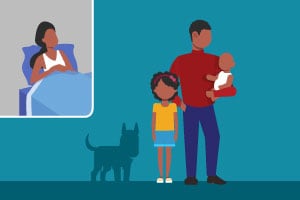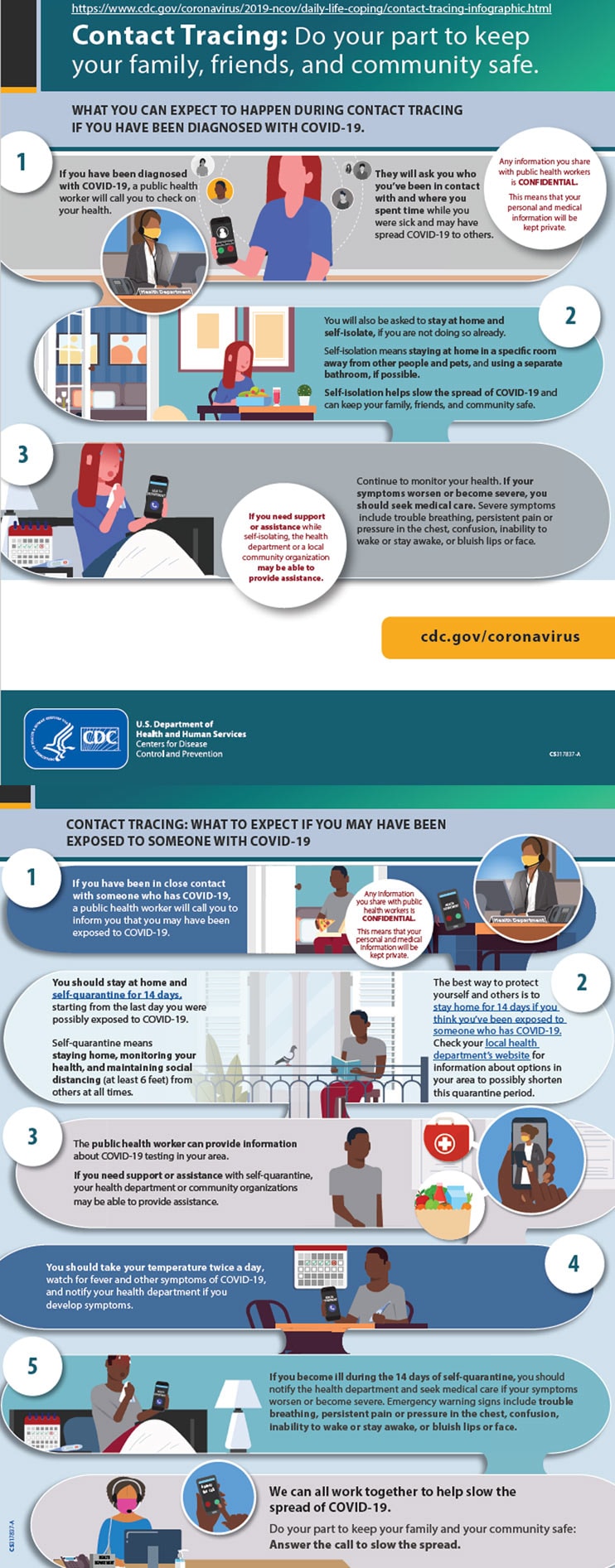 |
|---|
หน้าหลัก | สุขภาพดี | สุภาพสตรี | การแปลผลเลือด | โรคต่างๆ | วัคซีน
Contact Tracing
Contact tracing is key to slowing the spread of COVID-19 and helps protect you, your family, and your community.
On This Page
What you can expect to happen if you're:
Contact tracing slows the spread of COVID-19
Contact tracing helps protect you, your family, and your community by:
During contact tracing, the health department staff will not ask you for:
Contact tracing for COVID-19 works best with everyday preventive actions
You can take everyday preventive actions to slow the spread of COVID-19. Doing so is especially important until a vaccine or better treatments become widely available. At this time, if you have been vaccinated for COVID-19, you should follow existing CDC guidance on when and how long to self-isolate if you have COVID-19 or self-quarantine if you are a close contact. CDC continues to closely monitor the evolving science for information that would warrant changes to the recommendations for quarantine of close contacts.
What you can expect to happen
If you were around someone diagnosed with COVID-19
If you were around someone who has been diagnosed with COVID-19, someone from the health department may call you.

Stay home and away from others:
For COVID-19, a close contact is anyone who was within 6 feet of an infected person for a total of 15 minutes or more. An infected person can spread COVID-19 starting from 48 hours (or 2 days) before the person has any symptoms or tests positive for COVID-19. A person is still considered a close contact even if they were wearing a mask while they were around someone with COVID-19.
Monitor your health:
Answer the phone call from the health department. If someone from the health department calls you, answer the call to help slow the spread of COVID-19 in your community.
Tell the health department staff if you develop symptoms of COVID-19. If your symptoms worsen or become severe, you should seek emergency medical care.
Did you know? Health department staff may use case management or exposure notification digital tools to help with contact tracing. Learn more about these types of digital tools.
If you are waiting for a COVID-19 test result
If you think you may have COVID-19 and are waiting for a COVID-19 test result, stay home and monitor your health to protect your friends, family and others from possibly getting COVID-19.
Download and print the flyer: 3 Key Steps to Take While Waiting for Your COVID-19 Test Results pdf icon[224 KB, 2 pages]
Stay home and away from others:
Monitor your health:
Think about the people you have recently been around. While you wait for your COVID-19 test result, think about everyone you have been around recently. This will be important information to have available. If your test is positive, someone from the health department may call you to check on your health, discuss who you have been around, and ask where you spent time while you may have been able to spread COVID-19 to others.
Follow your health department’s guidelines when you receive your COVID-19 test result.
If you are diagnosed with COVID-19
If you are diagnosed with COVID-19, someone from the health department may call you to
Discussions with health department staff are confidential. This means that your name and personal and medical information will be kept private and only shared with those who may need to know, like your health care provider.
Any information you share with health department staff is CONFIDENTIAL. This means that your name and personal and medical information will be kept private.

Stay home and away from others:
You will be asked to stay at home and self-isolate, if you are not doing so already.
Monitor your health: If your symptoms worsen or become severe, you should seek emergency medical care.
You can be around others after
Tell your close contacts.
Download and print the flyer: How To Talk To Your Close Contacts pdf icon[1 MB, 2 Pages]
How To Talk To Your Close Contacts
What To Do If You Have COVID-19
Slow The Spread Of COVID-19
People diagnosed with COVID-19 can still spread the virus even if they don’t have any symptoms.
If You Have COVID-19

Stay Home. Don’t leave your home except to get medical care if needed. Avoid being around others for at least 10 days since symptoms first appeared. This includes 24 hours with no fever, without use of fever-reducing medication, and without other symptoms of COVID-19. For those without symptoms, stay home for at least 10 days after your positive specimen collection date.

Protect Those In Your Household by wearing a mask, staying at least 6 feet away from others in your household, washing your hands often with soap and water for at least 20 seconds, not sharing personal household items (for example, cups, plates), cleaning high-touch surfaces in shared spaces, and improving ventilation in your home. See suggestions for those living in close quarters and shared housing.

Notify Close Contacts and let them know you have COVID-19 so that they can quarantine at home and get tested. You are still considered a close contact even if you were wearing a mask while you were around someone with COVID-19.
For COVID-19, a close contact is anyone who you were within 6 feet for a combined total of 15 minutes or more over a 24-hour period.
An infected person can transmit SARS-CoV-2, the virus that causes COVID-19, starting 48 hours (2 days) before they have symptoms or their positive specimen collection date. Please note people who are infected but do not show symptoms (asymptomatic) and those who do not yet have symptoms (pre-symptomatic) can spread the virus to others. People who have been in close contact with someone who has COVID-19 should quarantine. People with recent exposure to COVID-19 who have been fully vaccinated may not be required to quarantine. People who were previously diagnosed with COVID-19 within the last three months may not be required to quarantine.
Who Are Your Close Contacts?
People you have been around during the two-day period prior to the start of your symptoms (or if you are asymptomatic, two days before your positive COVID-19 specimen collection date), through to the time you start isolation, are at greatest risk of infection and should be prioritized for notification.
Make A List Of Close Contacts To Notify. Think About:

By letting your close contacts know they may have been exposed to COVID-19, you are helping to protect them and others within your community. You can call, text, or email your contacts. If you would like to stay anonymous, there is also an online tool that allows you to tell your contacts by sending out emails or text notifications anonymously (tellyourcontacts.orgexternal icon).
An example of what to say to your contacts:
“Hi. I need to talk to you about something important. Do you have a few minutes to talk privately? I was diagnosed with COVID-19 (or tested positive) on xxx date. We spent time together on xxx date, and I wanted to let you know, so that you can get tested, protect your family and others within and outside your household. CDC recommends that you stay home, separate yourself from others for 14 days except to get medical care, get tested for COVID-19, and continue to monitor your health for symptoms of COVID-19.”
Download and print: How To Talk To Your Close Contacts: What To Do If You Have COVID-19 pdf icon[956 KB, 2 Pages]
Contact Tracing Steps – Infographic
Accessible content below image
paper iconDownload and print: Contact Tracing Stepspdf icon pdf icon[1.8 MB, 2 pages]
Alternative languages: Chinese | Español | Korean | Marshallese | Vietnamese

Contact Tracing: Do your part to keep your family, friends, and community safe.
What you can expect to happen during contact tracing if you have been diagnosed with COVID-19.
If you have been diagnosed with COVID-19, a public health worker will call you to check on your health.
They will ask you who you’ve been in contact with and where you spent time while you were sick and may have spread COVID-19 to others.
Any information you share with public health workers is CONFIDENTIAL. This means that your personal and medical information will be kept private.
You will also be asked to stay at home and self-isolate, if you are not doing so already.
Self-isolation means staying at home in a specific room away from other people and pets, and using a separate bathroom, if possible.
Self-isolation helps slow the spread of COVID-19 and an keep your family, friends, and community safe.
If you need support or assistance while self-isolating, the health department or a local community organization may be able to provide assistance.
Continue to monitor your health. If your symptoms worsen or become severe, you should seek medical care. Severe symptoms include trouble breathing, persistent pain or pressure in the chest, confusion, inability to wake or stay awake, pale, gray, or blue-colored skin, lips, or nail beds, depending on skin tone.
Contact Tracing: what to expect if you may have been exposed to someone with COVID-19
If you have been in close contact with someone who has COVID-19, a public health worker will call you to inform you that you may have been exposed to COVID-19.
You should stay at home and self-quarantine for 14 days, starting from the last day you were possibly exposed to COVID-19.
Self-quarantine means staying home, monitoring your health, and maintaining social distancing (at least 6 feet) from others at all times.
The best way to protect yourself and others is to stay home for 14 days if you think you’ve been exposed to someone who has COVID-19. Check your local health department’s website for information about options in your area to possibly shorten this quarantine period.
Any information you share with public health workers is CONFIDENTIAL. This means that your personal and medical information will be kept private.
If you need support or assistance with self-quarantine, your health department or community organizations may be able to provide assistance.
The public health worker can provide information about COVID-19 testing in your area.
You should take your temperature twice a day, watch for fever and other symptoms of COVID-19, and notify your health department if you develop symptoms.
If you become ill during the 14 days of self-quarantine, you should notify the health department and seek medical care if your symptoms worsen or become severe. Emergency warning signs include trouble breathing, persistent pain or pressure in the chest, confusion, inability to wake or stay awake, pale, gray, or blue-colored skin, lips, or nail beds, depending on skin tone.
We can all work together to help slow the spread of COVID-19.
Do your part to keep your family and your community safe: Answer the call to slow the spread.

